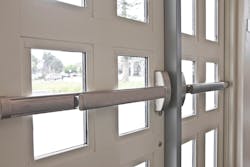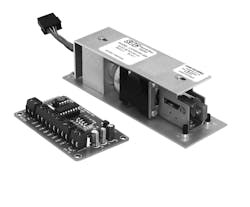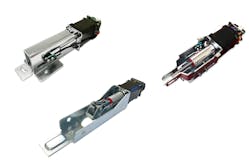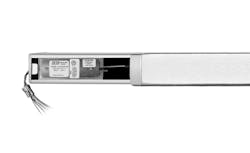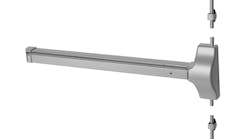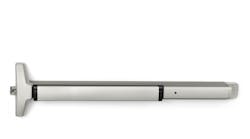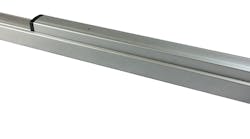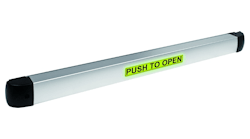Many pieces of hardware can be electrified. But not many can be upgraded to add power without replacing the entire unit. The exit device is one of those.
When it comes to moving from mechanical to electric, security pros have the option of replacing a mechanical exit device with one that’s electrified or adding a retrofit electrification kit to the existing device. Command Access and SDC have made retrofit kits for exit devices for years, and other manufacturers allow for retrofitting their own mechanical exit devices.
Of course, several manufacturers make exit devices where the electronics are already in place, so all the security pro has to do is install the hardware and connect it to a power source. That doesn’t necessarily mean, however, that replacement is always the easier option.
“Like everything else in the business, it’s all very much the application determines the hardware,” says Seth Strong, vice president and lead electronic technician with Ashland Lock and Security Solutions in Chicago. “The retrofit kit is oftentimes the easiest installation for something like a rim device or a surface vertical rod, because it’s cost-effective and it’s simple to do.”
Make no mistake: All things being equal, a retrofit kit will cost much less than a new exit device, particularly if the opening wasn’t electrified previously and requires pulling wires. But in the field, all things aren’t equal. Although cost is a major factor in determining whether to replace or retrofit an exit device, it shouldn’t be the only one.
With that in mind, here are four things that security pros should look out for when electrifying an exit device.
1. The Existing Exit Device
Aside from obvious considerations, such as the practicality of running electricity to a particular opening, the condition of an existing exit device will play a big role in whether retrofit or replacement is the better option. Everyone interviewed for this article agrees that wear is a particularly important barometer, much more than the age of an existing exit device, because certain products are built to last longer than others.
“You just have to make sure that everything is in good shape,” says Jacob Myers, president of C&M Security in San Antonio. “Is it going to last as long as your retrofit kit is?” If it likely won’t, then you should replace the exit device.
Myers notes one recent such experience. The job was with a previous client who sent a picture of a door, asking merely whether the door could be electrified. Yes, came the quick reply.
“So, we order the electrified kit, but when we get there, the panic bar is completely worn out,” he says. “I tell them, ‘Look I can do this, but we’ll be back for a service call, and I’m going to tell you that this panic bar needs to be replaced.’ So, we replaced the panic bar, and we still did the retrofit kit.
“Had I known that we were going to replace the whole thing, I would have just ordered the panic bar already electrified.”
Med Mosher, support facilitator for SDC, which makes electrified exit devices in addition to retrofit kits, agrees that the condition of an exit device meant to be electrified is crucial.
“They send you a picture,” he says of providing technical support to security pros. “They’re having trouble putting our device in another manufacturer’s [exit] device. The pictures that we see kind of shock you, like ‘why are you calling me? This whole device needs to be replaced.’”
So, check the condition of the existing exit device to make sure it functions properly before determining whether to retrofit or replace. Make sure that the push pad operates, the device latches completely and that there’s no binding. Also, check for potential binding on any vertical rods.
2. The Bar Length
When you inspect the condition, make sure to examine the length of the exit device, because that could be a crucial distinction in determining whether to retrofit or replace.
“The retrofit kits are very particular in the size that they come,” Strong says. “It’s all about the bar length.”
In particular, it’s all about whether the bar has been cut down to fit a smaller opening, says Mateo Kristoff, director of sales and marketing at Command Access, because a cut-down exit device could make it so a retrofit kit won’t fit the exit device, and the unit then would have to be replaced.
“This is kind of a big one that people can miss,” he says. “You’re thinking, ‘Oh that just looks like an Adams Rite 8800,’” and you order a retrofit kit for that exit device based solely on the door width. “And then you come back, you didn’t do the original install and you didn’t think to measure and [find out] they’ve cut 3 inches off, and there’s no room in the back anymore” for the electrification device. “You want to make sure that you have enough room in the back to install our kits.”
SDC agrees, and although it offers a smaller electrification kit, the LR100-EM, for exit devices down to 30 inches, that solution provides its own installation challenges, says Mauricio Lainez, SDC product development manager. EM variations are two-piece units, with the controller board placed externally.
“Instead of just running two wires for the power, now I have eight wires that I have to run,” he explains, “Because I’m running not just the power, but all the control information for the motor itself.”
So, make sure the exit device hasn’t been cut and is a standard measure, and, it almost goes without saying, check with the manufacturer to make sure any retrofit kit will fit the exit device in question.
3. The Opening Itself
It isn’t enough to inspect the condition of the exit device to help to determine what type of electrification might be more suitable. You also have to check the condition of the door and any other hardware that’s on it, because it could lead to problems later.
Mosher adds the following to a pre-electrification door inspection:
- Warpage in the door
- Whether the door has a closer
- Whether the hinges are in good working order
- Whether the door swing is normal
If the opening hasn’t been electrified previously, Kristoff says, you also have to check for how you’ll transfer the power at the door, whether through a door loop or, potentially, the hinge.
It comes down to time and, again, expense. A full retooling of a door could change the budget and result in the necessity of a lower priced electrification solution.
“We have to make sure that everything functions correctly,” says Noe Ortiz, electrical technician at Grah Lock & Safe in San Diego. “If everything checks out, then you do your electrification. That’s going to save you a lot of time and a lot of pain later.”
Then, there’s the issue of what purpose the door is meant to serve. A security pro has to be careful with an exit device on a fire-rated door, because any substantial change to a fire-rated door requires recertification.
This could lead to the decision to retrofit rather than replace, because UL, which tests and lists for fire doors, allows a UL Listed product to be installed in another UL Listed product without voiding the original listing.
“The last several times that I’ve done anything on a fire-rated door, we’ve retrofitted it, because we’ve been lucky enough that the panic hardware has been fairly new or still in great shape,” Myers says.
4. The Available Power
Of course, the biggest issue with any electrification, exit device or otherwise, is the available power.
Everyone interviewed mentions power as a major consideration. Strong, in fact, puts it No. 2 behind the bar length. You have to ensure “that you have the correct voltage and the correct wire size for the amperage that you’re going to work with,” he says.
Kristoff notes the importance of checking the wiring at an opening that already was electrified. You should make sure that 18- or 20-gauge wire is run to the door and that on double doors, dedicated wire is run to each side.
“Some situations will come up [where] one leaf fires and one tries to fire and drops out and you’ll have a problem,” he says. “That’s because they ran one pair of 18 [gauge wire] above the door and then split it, so they’re trying to power two devices off one set of wires, and it just isn’t going to work.”
“People don’t realize power supplies wear out, too,” says Kerby Lecka, director of marketing at SDC, adding that you might get to a job and discover a 10-year-old power supply. “Don’t mess with it. Just get another one to avoid the hassles, the trouble, the callbacks — all those kinds of things.”
You should know that a recent change in the electrification of exit devices has been beneficial to security pros in terms of installation. More kits and exit devices use a motor to drive latch retraction instead of a solenoid. This has led to fewer amps required to power the latch, in the neighborhood of 1–1.5 amps, instead of as much as 16 for solenoid-driven exit devices.
As a result, installers aren’t as beholden to using a power supply from the same manufacturer as the exit device as they used to be.
“For example, in Von Duprin or Adams Rite exit devices, sometimes you needed to use a special power supply, or power supplies had to have high amperage in order for that solenoid to pull hard,” Ortiz says. “But motorized is more forgiving. You can use a lot of different power supplies.” An added benefit, he notes, is that the motorized latch retraction also is quieter. “You don’t have a big, old ‘thunk.’”
Myers agrees that security pros have more options available to them. He says he has used Allegion equipment paired with an Allegion power supply and he’s used Command Access electrification kits with other power supplies, with no notable difference in basic performance.
“You have to weigh your pros and cons,” he says of either method. “If you trust [the product] and you know it’s going to work and they’re the right thing for that application, then go for it.”
